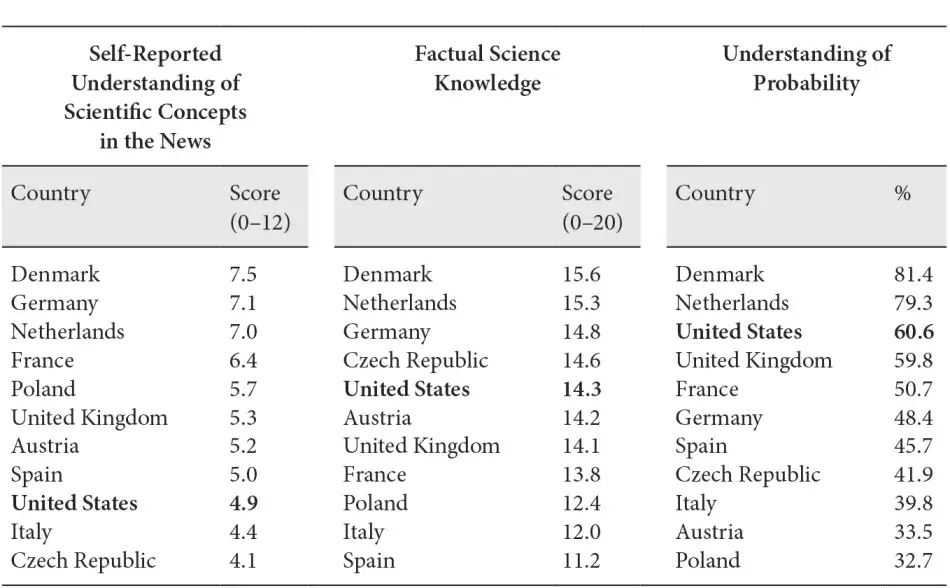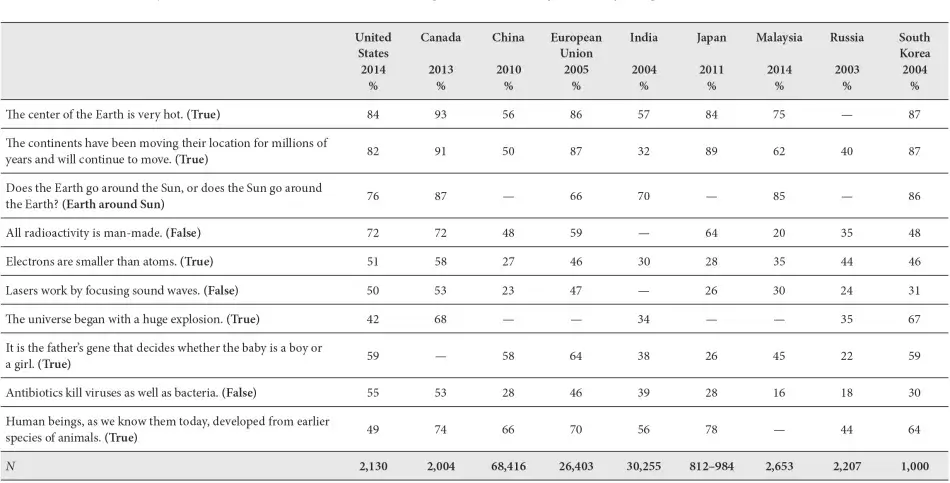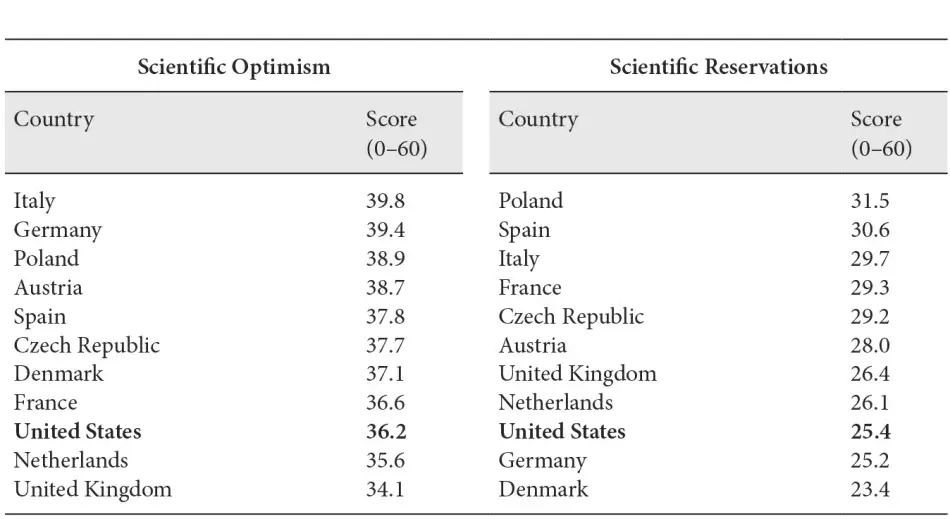Global Views of Science and Technology
Civic Science Literacy
In a first line of research assessing cross-national differences in how publics relate to science and technology, some scholars have focused on measuring “civic science literacy,” comparing scores on quiz-like questions among representative samples of adults surveyed in the United States, Europe, and Asia. Knowledge of basic scientific ideas and concepts is essential, argue these scholars, if individuals are to participate in politics and public affairs, compete in the workplace, and succeed at practical aspects of daily life. Given this importance, tracking and comparing science knowledge across countries provides an important indicator of a nation’s civic health and capacity.6
Civic science literacy has been measured in national surveys by way of two separate but related knowledge constructs. First is the understanding of factual terms and concepts. These questions are intended to represent a vocabulary of basic scientific constructs sufficient to read opposing views in a newspaper. Examples of questions tapping factual knowledge include true-or-false questions — assessing statements such as “lasers work by focusing sound waves,” “electrons are smaller than atoms,” and “antibiotics kill viruses as well as bacteria” — as well as multiple-choice questions — “does the Earth go around the Sun, or does the Sun go around the Earth?” or “which travels faster: light or sound?”
In the United States, the biannual National Science Board surveys have for decades asked a consistent set of nine such questions. Since 2001, the average number of correct answers to the nine questions has ranged from 5.6 to 5.8. Better-educated Americans score higher than their less-educated counterparts. For example, those with a graduate degree tend to answer about 80 percent of the questions correctly, compared with 60 percent among those with a high school education. Overall, for several decades, scores on these questions have remained relatively stable and are mostly a function of formal education levels, particularly the number of college-level science courses completed.7
A second dimension of civic science literacy has been defined as knowledge of science as a process or mode of inquiry, measured by way of three types of questions assessing understanding of probability, experimental designs, and what it means to study something scientifically.8 The percentage of Americans answering these questions correctly have remained relatively stable going back to the 1990s, with the number of science courses completed by an individual strongly predictive of knowledge.
The most recently available surveys comparing civic science literacy between the United States and other countries was commissioned in 2011 by the BBVA Foundation of Spain.9 The project included face-to-face interviews with a nationally representative sample of 1,500 people living in the United States and in each of ten European countries. Three dimensions of knowledge were measured using similar question wording across all of the countries:
- Understanding of scientific concepts in the news: Respondents were asked if they understood completely, partly, or not at all specific specialist terms or expressions mentioned in the news media such as “the power of gravity,” “DNA,” “the greenhouse effect,” “atom,” and “ecosystem.”
- Factual science knowledge: Respondents were asked true-or-false–style questions such as “hot air rises,” “Earth’s gravity pulls objects toward it without them being touched,” and “the earliest humans lived at the time of dinosaurs.”
- Understanding of probability: Respondents were asked a question about the probability of a couple’s likelihood of having a child with a hereditary disease.
As Table 1 indicates, Americans score comparatively lower on self-reported understanding of specific concepts in the news, rank fifth among eleven countries in terms of factual science knowledge (though country differences are not substantial), and rank third specific to understanding of probability. The top scoring countries across all three dimensions were the Northern European countries Denmark, the Netherlands, and Germany. Scholars have previously surmised that Americans on average score better on science literacy measures than the average European because of the unique nature of the U.S. education system, which exposes students at the high school and college levels to a broad base of course work that includes science classes. In contrast, many EU students start to narrowly specialize early on during their high school years and through college. As a consequence, nonscience majors in the European Union may miss out on the valuable “civic science” education that U.S. students receive.10

In terms of other available cross-national comparisons, the authors of the 2017 National Academies of Sciences, Engineering, and Medicine report Science Literacy: Concepts, Contexts, and Consequences summarized the most recently available country-specific data from a variety of independent surveys for which consistent question wording was used (see Table 2). As the authors observe, “scores for individual items vary from country to country, and no country seems to outperform the others on every question.” In conclusion, they write that countries “with similar measures of economic development and educational attainment tend to have similar average scores on measures of science knowledge.” They recommend that more research should focus on how social structural and country-level differences may either enable or limit access by individuals to opportunities for science-learning and participation. Similarly, they emphasize that a focus on average national scores obscures what are likely to be wide variations in science literacy within a country based on socioeconomic background or other factors.11

Beliefs about Science, Technology, and Society
Despite the attention that survey measures of science literacy receive, the authors of a 2008 meta-analysis of 1,930 public opinion surveys conducted across forty countries concluded that there is only a weak relationship between science literacy and public attitudes about science. In the years since, authors of other studies have observed that attitudes about food biotechnology, climate change, or biomedical research are more likely to vary in relation to social background, identity, mental models, and information sources than to knowledge.12
Reviewing this evidence, the members of a National Academies of Sciences, Engineering, and Medicine committee on science literacy concluded in 2016 that “available research does not support the claim that increasing science literacy will lead to appreciably greater support for science in general.”13 Once factors such as individual background, values, and information sources are accounted for, concluded the authors of a separate National Academies report published the following year, the “relationship between knowledge and attitudes across studies is either weakly positive, nonexistent, or even negative.”14
Though science literacy likely plays only a minor role in shaping public attitudes, past research has identified two major mental models about science, technology, and society that people across countries tend to rely on to draw inferences, retrieve information from memory, form judgments, and generate opinions. Once activated by events, experiences, conversations, or messages, these mental models likely serve as shortcuts for evaluating a topic such as stem cell research, gene editing, or genetically modified food, and for estimating the trustworthiness of scientists and their institutions as sources of information.15
The first mental model, scientific optimism, is an attitude construct representing respect for the intentions of scientists, a sense that science and technology provide useful results and products for society, and the assumption that future benefits from science and technology are likely. Questions typically used to measure this construct ask respondents to agree or disagree with statements such as “scientific research is essential for improving the quality of human lives” and “new technology used in medicine allows people to live longer and better.” The second schema, scientific reservations, is an attitude construct reflecting public concerns about the speed of change in modern life and a sense that science and technology pose conflicts with traditional values or belief systems. Questions measuring this mental model ask respondents to agree or disagree with statements such as “scientific research these days doesn’t pay enough attention to the moral values of society” and “it is not important for me to know about science in my life.” In the U.S. context, the two schema tend to be negatively correlated with one another. Thus, individuals who strongly believe in the promise of science and technology are generally less likely to have concerns about negative impacts.16
In previous studies examining public opinion about biomedical research, for example, even after controlling for partisanship and ideology, those scoring high on scientific reservations were on average more likely to oppose human genetic engineering and embryonic stem cell research. In contrast, those scoring high on scientific optimism were more likely to support such advances. Overall, these two mental models were the strongest predictors of attitudes, outweighing the influence of social demographics, religiosity, and ideology.17
The 2011 BBVA Foundation survey of public attitudes across ten European countries and the United States included a comprehensive battery of questions measuring beliefs about science, technology, and society. Scientific optimism was evaluated using a composite index of answers to questions asking respondents to agree or disagree with the following statements:
- Science is the motor of progress.
- Thanks to science, people’s health is improving all the time.
- Science is central to a society’s culture.
- Science has reduced the fears and the superstitions of the past.
- Science is the best way to understand the world.
- Science promotes a freer society.
- Science has an answer for all the major problems in the world.
Similarly, scientific reservations were evaluated using a composite index of questions asking respondents to agree or disagree with the following questions:
- Science makes our way of life change too fast.
- Science has made everything more complex and hard to understand.
- People would be better off if they lived a simpler life, without so much science and technology.
- Technological progress creates an artificial and inhuman way of life.
- Science increases the risk of war.
- Science has created a world that is full of risks for people in their daily life.
- Technological advances are among the main reasons for today’s high unemployment.
- Scientists should not change the workings of nature.
- Science harms rather than helps the environment.
- Sciences drive out religion.
- Science destroys people’s moral values.
As Table 3 indicates, the authors found “no marked inter-country differences” in scores on scientific optimism and scientific reservations, only slight variations.18 All of the countries scored relatively higher on scientific optimism than scientific reservations. Overall, however, scientific reservations tended to be lower in countries where scientific activity and technological development were the most intense and productive, such as the United Kingdom, the Netherlands, the United States, Germany, and Denmark.

Modernization, Cultural Values, and Inequality
Among the main observations put forward by scholars to explain differences in beliefs about science, technology, and society across countries is the postindustrial paradox: as societies transition from industrial to postindustrial economies, public attitudes about science and technology evolve. In contrast to less-developed countries, in more-advanced economies like the United States and those of Northern Europe, science and technology may no longer be idealized as necessary to economic growth or national identity. The populations of these countries are still likely to expect benefits from scientific advances, but they are also likely to be more sensitive to the potential risks of innovations such as food biotechnology or gene editing. The public may also be less willing to fund science given other societal priorities like addressing inequality.19
Researchers testing these assumptions via survey studies observed that among European countries in the 1990s, interest in science was greatest among nations with low- to mid-levels of development but dropped off among European countries that had achieved the highest levels of modernization and standards of living. Similar patterns related to public attitudes about science were observed by researchers analyzing survey data collected during the 2000s in India, China, and Europe. Among Chinese and Indians, science and technology were viewed with strong levels of optimism, but Europeans living in richer, more-modernized countries tended to be more ambivalent about the benefits and costs of scientific advancement.20
A second related line of scholarship does not focus specifically on science and technology attitudes but rather on how such opinions are embedded within a broader process of cultural modernization taking place at different rates and in different ways around the world. This process of modernization in turn can be explained by the philosophical, political, religious, geographical, and economic history of a country and its people. Analyzing several decades of findings from cumulative World Values Surveys, these scholars argue that populations of countries vary in terms of traditional values versus secular-rational values. Populations in countries with more-traditional values may express stronger reservations about the impact of science and technology on religious faith or the speed of change than those living in nations scoring higher on secular-rational values.21
Countries also differ in terms of survival versus self-expression values. In developing countries, populations are likely to feel less secure about their economic status, their personal well-being, and the place of their nation in the world. Scientific advances and innovations are therefore more likely to be viewed as necessary to survival, well-being, and prosperity, with populations in less-developed countries expressing more optimism and fewer reservations than their counterparts living in more-developed nations. Specific to self-expression, those countries that have achieved economic growth and development, according to this line of research, tend to score higher in terms of democratic freedoms. In contrast to more-authoritarian, less-developed countries, populations living in advanced democracies not only may feel more ambivalent about the benefits and impacts of science and technology, but the personal freedoms they enjoy may make them more likely to express their reservations.22
Notably, in studies conducted by authors analyzing the World Values Survey, the United States scores higher in traditional values than other advanced Western economies, but also higher in terms of self-expression values compared with most other nations. This unique combination of a population holding more-traditional values but also enjoying the personal freedom to express opinions based on those values may have unique influences on beliefs about science, technology, and society.